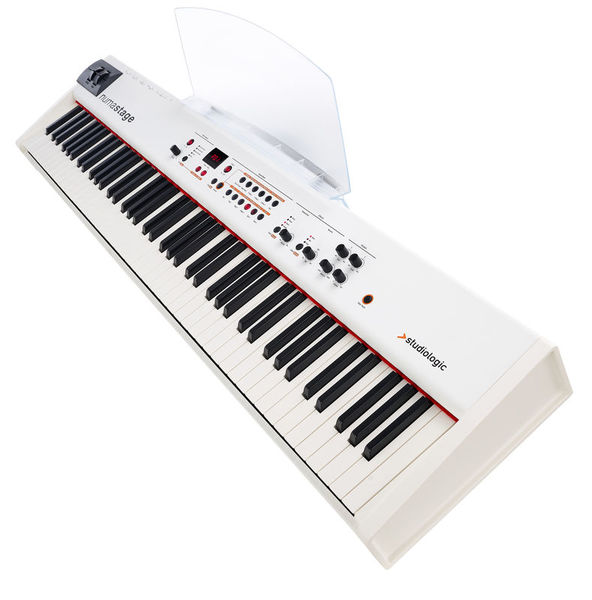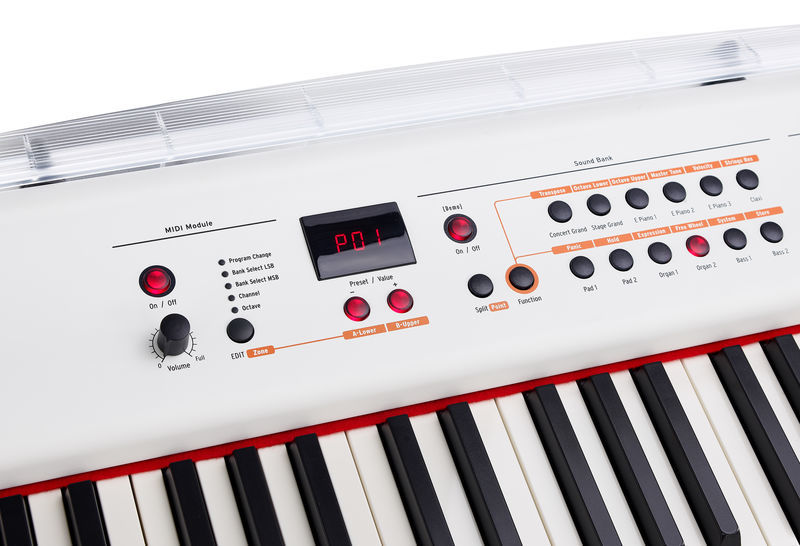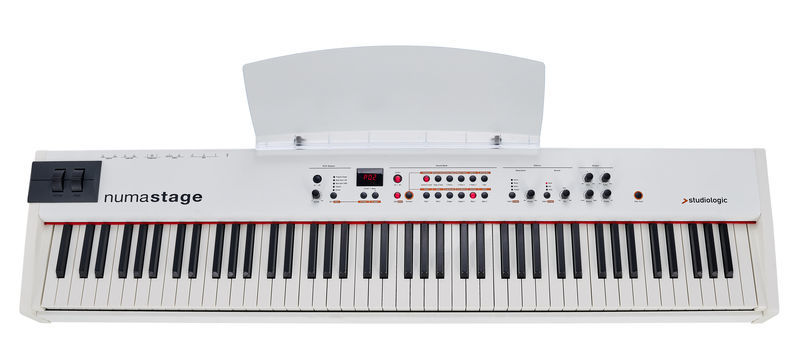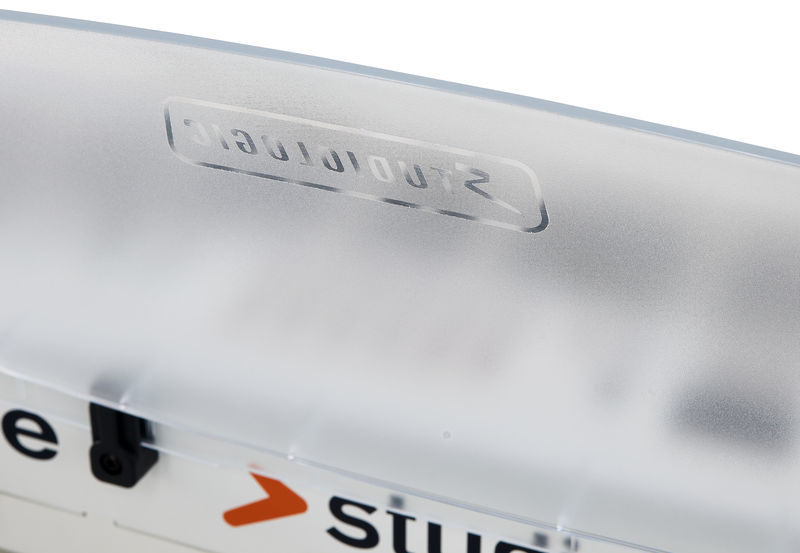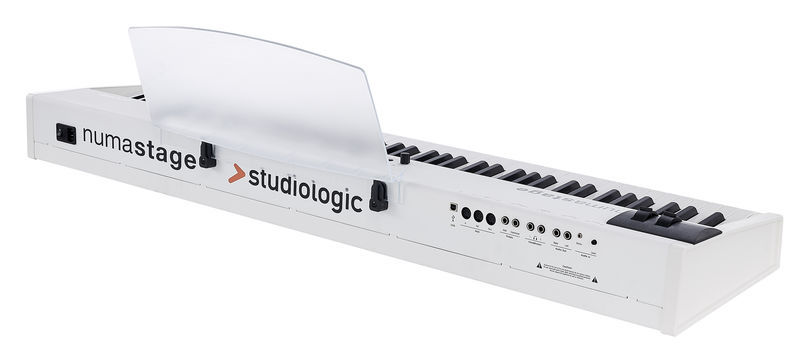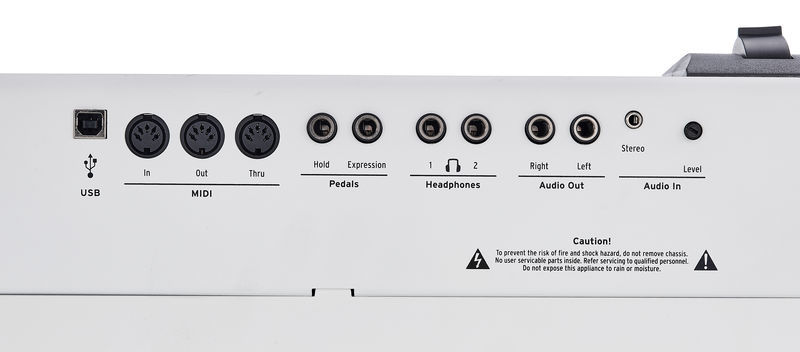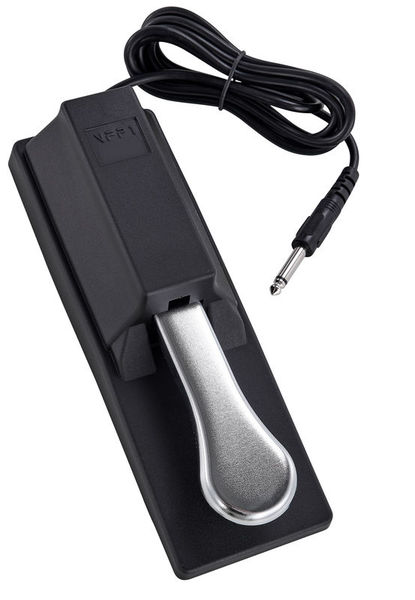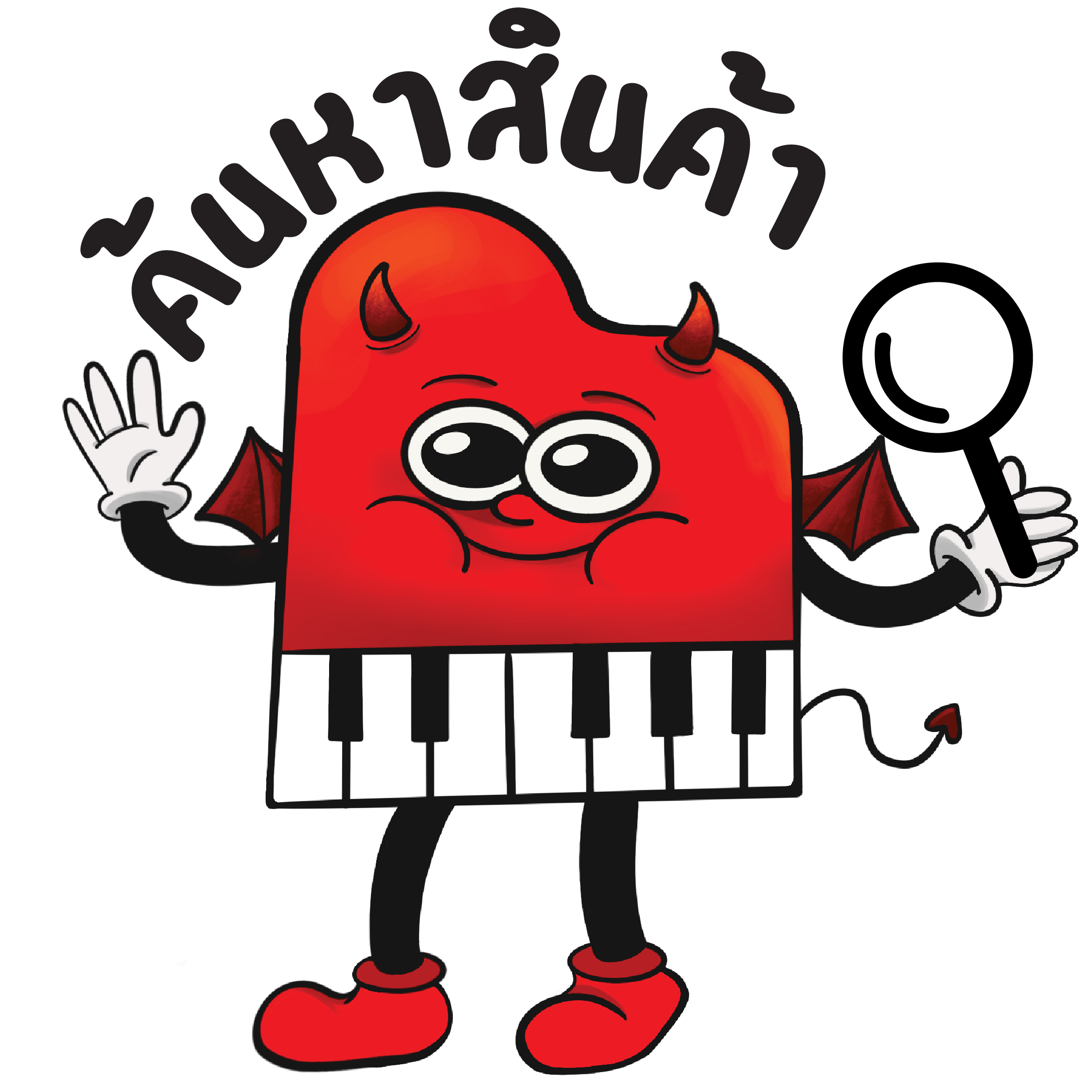
เปียโนไฟฟ้า Studiologic Numa stage
Digital Piano Studiologic Numa stage
Stage Piano Numa Stage
- 88 Keys with weighted hammer action (FATAR TP/100LR-3C)
- 3 Editable velocity curves
- 10 Velocity curves with FATAR TOUCH system
- Floating point DSP with True Sound technology sound generation
- Sounds: Concert grand, stage grand, electric piano 1 - 3, clavi, pad 1 & 2, organ 1 & 2, bass 1 & 2
- Independent on/off for MIDI zone A and MIDI zone B
- Effects: 4 x Modulation, 3 x reverb and equaliser
- Dimensions (W x D x H): 1300 x 305 x 120 mm
- Weight: 13 kg
Connectors
- 2 x Audio out (L/R)
- 1 x Stereo audio in (L/R)
- 2 x Headphones out
- 1 x USB
- 1 x MIDI in / out / thru
- 2 x Pedal (sustain / expression)
Studiologic Numa Stage
The lightness of the hammer.
Get ready for the stage.

Numa Stage is more than a simple musical instrument, since it combines the performance of a state-of-the-art digital piano and a powerful master keyboard. Designed as a natural evolution of the Numa Piano, it offers a powerfull sound generator based on the Studiologic TrS technology (True Sound) packed in an elegant and solid metal case. Its dimensions and weight are reduced to a very convenient portable size.
Numa Stage เป็นมากกว่าเครื่องดนตรีทั่วไป เนื่องจากเป็นการผสมผสานระหว่างการแสดงของเปียโนดิจิตอลที่ล้ำสมัยและมาสเตอร์คีย์บอร์ดอันทรงพลัง ได้รับการออกแบบตามวิวัฒนาการตามธรรมชาติของ Numa Piano โดยนำเสนอเครื่องกำเนิดเสียงอันทรงพลังที่ใช้เทคโนโลยี Studiologic TrS (True Sound) ที่บรรจุในกล่องโลหะที่หรูหราและแข็งแกร่ง ขนาดและน้ำหนักของมันลดลงเหลือขนาดพกพาที่สะดวกมาก


Performance with the right sounds.
A selection of 12 best in class sounds easy to manage through a direct control panel. The instrument provides amazing piano sounds based on 9 dynamic levels interpolated in real time and loudness parameters.
Resonance like the real thing.
The new sounds are further made very natural and realistic by the new String Resonance modeling that allows to control and reproduce all the real resonances found in an acoustic piano made by the chords, the damper and the soundboard itself.
ประสิทธิภาพพร้อมเสียงที่เหมาะสม
ตัวเลือกที่ดีที่สุด 12 รายการในกลุ่มนี้ฟังดูง่ายในการจัดการผ่านแผงควบคุมโดยตรง เครื่องมือนี้ให้เสียงเปียโนที่น่าทึ่งโดยอิงจากระดับไดนามิก 9 ระดับที่สอดแทรกแบบเรียลไทม์และพารามิเตอร์ความดัง
เสียงสะท้อนเหมือนของจริง
เสียงใหม่นั้นถูกสร้างขึ้นมาอย่างเป็นธรรมชาติและสมจริงยิ่งขึ้นด้วยการสร้างโมเดล String Resonance ใหม่ ซึ่งช่วยให้สามารถควบคุมและสร้างเสียงสะท้อนที่แท้จริงทั้งหมดที่พบในเปียโนอะคูสติกที่สร้างจากคอร์ด แดมเปอร์ และซาวด์บอร์ด

Versatile and portable.
Underneath the solid metal case, Numa Stage is equipped with a Fatar’s TP/100LR keyboard.
You will experience a unique touch and feel sensation that truly deserves the claim of “Excellent”.

- 88 Keys, TP/100LR Premium Hammer Action
- Triple switch detection system
- Touch
- Soft, Medium, Hard, Fixed (programmable)
- 10 user’s velocity curves with auto-learning system (Fatar Touch)
- Max Polyphony 128 voices
- 2 Parts
- 12 tones
- 2x Acoustic piano, 3x Electric Piano, Clavi, 2x Pad, 2x Organ, 2x Bass
- TrS (True Sound) Stereo multi-samples
- Physical modelling resonance (strings/sympathetic/soundboard)
- Master Volume
- Bass, Treble
- Balance Lower / Upper
- Modulation FX: Chorus, Phaser, Rotary, Tremolo
- Reverb FX: Room, Hall, Delay
- 50 User’s Presets
- Effects Auto-set function
- 2 Parts Split/Layer (programmable Split point)
- Editable Functions
- Transpose (±12), Octave Lower, Octave Upper, Master tune, Velocity, String Resonance, Panic, Hold (layer assign), Expression (layer assign), Free wheel
- MIDI Module
- 2 Zones Split/Layer
- Program Change, Bank Select /LSB, MSB), MIDI Channel, Octave
- MIDI Volume
- Display 7 segments, 3 digits
- Pitch Bend wheel
- Free wheel (effect, modulation)
- Sounds
- Sounds Section On/Off button
- 12x Sound/Function selection buttons
- Split button
- MIDI Module
- Section On/Off button
- Functions selection
- Volume
- Effects
- 2x Effects selection buttons
- 2x Effects control knobs
- 4x Control knobs
- Audio OUT: 2x 6,3 mm mono jack (L+R)
- Audio IN: 3,5 mm mini stereo jack
- Headphones: 2x 6,3 mm stereo jack
- Pedals: Hold, Expression
- MIDI: In, Out, Thru
- USB: USB to Host, MIDI Out
- AC IN: 110-240 V
- Width: 130 cm / 51,2″
- Depth: 31 cm / 12,2″
- Height: 15 cm / 6″
- Weight: 13 Kg / 28,7 lbs
- Numa Stage
- Studiologic VFP1/10 sustain pedal
- Music stand
- Power cord
Your new Numa Concert/Stage
Thank you very much for choosing the Studiologic. You have obtained a state-of-the-art keyboard made by the renowned manufacturer Studiologic.
The Numa Concert/Stage is easy to operate, and offers a perfect keyboard touch. We recommend that you read the entire manual carefully to take full advantage of all the functions.
An overview of the functions:
Hammer action keyboard
Internal Sounds
The Numa Concert/Stage offers the latest innovative techno- logy by Fatar: a sophisticated hammer action keyboard. It is therefore portable and offers a realistic grand piano touch for which Fatar is famous. You will love the touch and sound..
You can immediately start playing the 12 selected high qua- lity sounds, which have been carefully sampled. Experienced keyboard players and musicians selected those sounds and were involved in the design of the straightforward operati- on of Numa Concert/Stage. Therefore Numa Concert/Stage is your perfect partner on stage, in the studio or at home - re- gardless which kind of music you are performing. 128 voice polyphony is available to add depth and expression to your Music. It is possible to combine two sounds by layering or splitting the keyboard, and add the built-in modulation and reverb effects.
The masterkeyboard functions of the Numa Concert/Stage al- low you to control other MIDI devices, with two separate Midi Zones (A-lower, B-upper) that can be played in single, layer or split mode. Select the sounds of external instruments or mo- dules and adjust the levels directly from your Numa Concert/ Stage without the need of routing through other devices.
As well as the stereo audio output, the Numa Concert/Stage has two additional headphone outs. This is ideal for music schools and late-night jam sessions without disturbing the neighbours.
Plug your mp3-player or MIDI sound module into the audio input of the instrument Mix external audio devices directly with the sounds inside the Numa Concert/Stage.
The integrated USB port allows your Numa Concert/Stage to connect to your computer. You can use a USB and MIDI out for MIDI data transmission. In addition, updates of the firmware or the sound library are accessible via USB.
Numa Concert / Stage นำเสนอเทคโนโลยีที่เป็นนวัตกรรมล่าสุดโดย Fatar: คีย์บอร์ดแอ็คชั่นค้อนที่มีความซับซ้อน ดังนั้นจึงสามารถพกพาได้และให้สัมผัสของแกรนด์เปียโนที่เหมือนจริงซึ่งฟาตาร์มีชื่อเสียง แล้วคุณจะหลงรักเสียงสัมผัส..
คุณสามารถเริ่มเล่นเสียงคุณภาพสูงทั้ง 12 เสียงที่ได้รับการสุ่มตัวอย่างมาอย่างดีได้ทันที ผู้เล่นคีย์บอร์ดและนักดนตรีมากประสบการณ์ได้เลือกเสียงเหล่านั้นและมีส่วนร่วมในการออกแบบการทำงานที่ตรงไปตรงมาของ Numa Concert / Stage ดังนั้น Numa Concert / Stage จึงเป็นคู่หูที่สมบูรณ์แบบของคุณบนเวที ในสตูดิโอ หรือที่บ้าน ไม่ว่าคุณจะแสดงดนตรีประเภทไหน มีเสียงโพลีโฟนี 128 เสียงเพื่อเพิ่มความลึกและการแสดงออกให้กับเพลงของคุณ เป็นไปได้ที่จะรวมเสียงสองเสียงเข้าด้วยกันโดยการจัดเลเยอร์หรือแยกคีย์บอร์ด และเพิ่มการมอดูเลตในตัวและเอฟเฟกต์เสียงสะท้อน
ฟังก์ชันมาสเตอร์คีย์บอร์ดของ Numa Concert / Stage ช่วยให้คุณควบคุมอุปกรณ์ MIDI อื่นๆ ด้วย Midi Zone แยกกันสองโซน (A-lower, B-upper) ที่สามารถเล่นได้ในโหมดเดี่ยว เลเยอร์ หรือแยก เลือกเสียงของเครื่องดนตรีหรือโมดูลภายนอกและปรับระดับได้โดยตรงจาก Numa Concert / Stage ของคุณโดยไม่ต้องกำหนดเส้นทางผ่านอุปกรณ์อื่น
นอกจากเอาต์พุตเสียงสเตอริโอแล้ว Numa Concert / Stage ยังมีช่องเสียบหูฟังเพิ่มเติมอีกสองช่อง เหมาะอย่างยิ่งสำหรับโรงเรียนดนตรีและช่วงที่ติดขัดในช่วงดึกโดยไม่รบกวนเพื่อนบ้าน
เสียบเครื่องเล่น MP3 หรือโมดูลเสียง MIDI ของคุณเข้ากับอินพุตเสียงของเครื่องดนตรี มิกซ์อุปกรณ์เสียงภายนอกเข้ากับเสียงภายใน Numa Concert / Stage โดยตรง
พอร์ต USB ในตัวช่วยให้ Numa Concert / Stage เชื่อมต่อกับคอมพิวเตอร์ของคุณได้ คุณสามารถใช้ USB และ MIDI out สำหรับการส่งข้อมูล MIDI นอกจากนี้ การอัปเดตเฟิร์มแวร์หรือคลังเสียงยังสามารถเข้าถึงได้ผ่าน USB
All operation buttons are marked in bold italic in this manual (eg On/Off).
If you have to press two buttons at the same time, it is indicated by & (eg Split & Bass 2). You can either press both buttons at the same time, or press and hold one button while pressing the other button.
Key combinations with Function are always marked red in this manual. First press and hold Function while pressing the other button (eg Function & Transpose).
Values in the display of the are marked bold (eg P01).
To adjust the values, use the Value+/- buttons under the display. To make the value change in steps of 10 rather than 1, press and hold Value +/- below the display for a few se- conds.
ปุ่มการทำงานทั้งหมดเป็นตัวหนา ตัวเอียงในคู่มือนี้ (เช่น เปิด / ปิด)
หากคุณต้องกดสองปุ่มพร้อมกัน จะมีเครื่องหมาย & (เช่น Split & Bass 2) คุณสามารถกดทั้งสองปุ่มพร้อมกัน หรือกดปุ่มหนึ่งค้างไว้ในขณะที่กดปุ่มอีกปุ่มหนึ่ง
คีย์ผสมพร้อมฟังก์ชันจะทำเครื่องหมายเป็นสีแดงเสมอในคู่มือนี้ ขั้นแรกให้กดปุ่ม Function ค้างไว้ในขณะที่กดปุ่มอื่น (เช่น Function & Transpose)
ค่าในการแสดงจะถูกทำเครื่องหมายเป็นตัวหนา (เช่น P01)
ในการปรับค่า ให้ใช้ปุ่ม ค่า +/- ใต้จอแสดงผล หากต้องการเปลี่ยนค่าในขั้นตอนที่ 10 แทนที่จะเป็น 1 ให้กดค่า +/- ใต้จอแสดงผลค้างไว้สองสามวินาที
You will find tips and further information in text passages marked by the Studiologic logo.
How functions are shown in this manual
Display - Value +/- buttons
Control panel
Sound Bank
Sound, split and system configuration
Output
EQ and Volume adjustment
Value adjustment
On / Off
Volume
Program Change Bank Select LSB Bank Select MSB Channel
Octave
Zone
Concert GrandStage Grand
E Piano 1
Expression
Organ 1
E Piano 2
Free Wheel
Organ 2
Room Hall Delay
Select Assign
Min
Lower
Bass 0
Balance
Max Min
Upper
Treble
Volume
Max
MIDI Module
Fatar Touch
MIDI Module
EDIT
[Demo]
On / Off
Split Point
Transpose
Sound Bank
Octave Lower Octave Upper Master Tune
Velocity
E Piano 3
System
Bass 1
Strings Res
Clavi
Store
Bass 2
Effects
Modulation
Chorus Phaser Rotary Tremolo
Select Assign
Effects
Max
Reverb
Output
00
Masterkeyboard functions
Modulation / reverb effects
Create your own velocity curve
Audio out L/R
2x 6,3mm mono jack
Stereo audio in - Level
3,5mm stereo jack
Fuse
500mA, F, 250V
o II
Mains - Power
100V to 240V
o II
USB port
MIDI I/O and software updates
MIDI In-Out-Thru
MIDI send/receive
Hold - Expression pedal
Sockets for pedal connection
Headphone out 1/2
2x 6,3mm stereo jack
Preset / Value
Panic
Pad 1
Hold
Pad 2
50%
Mix
A-Lower
B-Upper
Function
Min
Amount
Dry
Wet
Fatar Touch
Connections / Back view
E
Control panel / Connections
Studiologic Numa Concert/Stage
5
Before using the product
Power connection
Music stand
Sustain / Expression pedal
Audio output Headphones Volume
Use the power chord supplied with the instrument to con- nect it to the power socket. Switch the unit on by using the power button near to the power socket.
The music stand supplied can be attached to the brackets on the back of the unit.
Connect the sustain pedal VFP 1 supplied with the unit at the socket which is labelled Hold.
At the socket labelled Expression, you can plug in the Studio- logic pedal VP 25, which is available as an option.
Note: If you would like to attach other pedals, please refer to the required specifications..
Connect the audio outputs Left and Right with the inputs of your mixing desk or amplifier etc.
Plug in your headphone(s) at one of the headphone outputs. You can use up to two headphones at the same time.
When you use the instrument for the first time, we recom- mend you to turn the Volume knob on the Output section to not more than half way between 0 and Full. While you are playing you can adjust the volume as you choose. Adjusting the Volume knob effects all audio and headphone outputs at the same time.
CAUTION:
To prevent hearing damage you should – as with all audio devices – avoid using the instrument at high volume for long periods.
You can plug in external audio devices, such as mp3-players for playback or MIDI sound modules, at the audio input. The Level knob near the jack on the back of the instrument is for adjusting the input level.
For data transmission via USB, connect the instrument to your computer with a USB cable. The first time you switch it on, the instrument will be recognized by your computer automatical- ly and the appropriate driver will be installed by the OS (class compliant).
Audio input
USB
6
Studiologic Numa Concert/Stage
Pitch
• Picth bend of ±2 semi tones
On/Off - Demo
• Sound engine on/off • Play Demo-songs
Sound Bank
Octave Lower Octave Up[pDermMoa]ster Tune
Sound Bank
• Direct access to the 12 internal sounds
Bass / Treble
• EQ: Cut / boost of low and high frequencies
MIDI Module
On / Off
Octave
Volume EDIT Zone
MIDI Module
Sound Bank
Effects
Strings Res
EffectOs utput
00 00
Program Change Bank Select LSB Bank Select MSB Channel
Phaser Min
Rotary Hall Rotary Hall
Preset / Value
Free Wheel System Store 50% 0
Tremolo Delay Tremolo Delay
On/Off
On / Off
Concert GrandStage Grand
E Piano 2
E Piano 3
Bass
Bass 0
Treble
[Demo]
Program Change Bank Select LSB Bank Select MSB
Transpose
Velocity
Modulation
Reverb
Modulation
Chorus
Reverb
Channel Octave
50%
E PianoOn1 / OEffPiano 2
E Piano 3 ConceCrltaGvirandStage Grand
E Piano 1
Phaser
Clavi
Room
Max
Min Room Max Treble
Min
Max
Min
Max
TSratrninspgossRees Octave Lower Octave Upper Master Tune Chorus
Velocity
PrePsaentic/ Value
A-Lower BV-Uoplupmere EDIT SZponlitePoint Function A-LowePrad1 B-UppePrad2 OrganSp1litPoinOtrganFu2nctionBass1 PBaadss12 Pad2 OrgaSne1lectAsOsirgnan2 MinBAamsso1untMaxBass2SelectAssign Dry SeMleixctAsWseigtn MinLAowmeoruBnatlaMnacxeUppeSrelectAsVsoiglunme Dry Mix Wet LFoawtearrBTaoluacnhceUpper Volume
Display - Value +/- Function
• Preset recall • in combination with Demo
and Transpose
Press and hold Demo for a few seconds to play the demo songs. They will start automatically and DEM is shown in the display. Use Value +/- to play the next or previous demo song. By pressing Demo again you quit the demo mode.
As long as the instrument displays P followed by a two digit number (eg P05) you can recall any preset by pressing Value +/-. There are 24 factory presets available (P01 – P24).
The sound engine can be activated or deactivated using the On/Off button.
To select a sound, use the 12 labelled buttons. The button of the selected sound lights up.
To adjust the sound of the instrument to the environment, you can cut or boost low and high frequencies using the Bass and Treble knobs in the Output section. Set the sound level with the Volume knob.
If you have to play in a different key, you can simplify this task by transposing the keyboard (eg: from F plus one semitone to F sharp).
To transpose in steps of a semi-tone, press Function & Transpose. Use Value +/- to change the transposition. If no transposition is used, 0 will be displayed. Adjustments of -6 to 5 semi-tones can be processed, to cover the entire range. Press Function again to keep the adjustment and quit transposition mode. The Transposition setting will be kept until the instrument power is switched off.
To temporarely vary the pitch while playing by ±2 semitones, use the Pitch wheel on the left. The wheel is self centering and will go back to its center position after being released (ie, no pitch applied).
Demo songs
Preset recall
Sound engine / Sound selection
EQ / Volume
Transpose
Hold
Expression
Free Wheel
System
PaSntoicre
Expression
Hold
Transpose Volume
• Transposition of the key- • Sound level board to other tunes
Pitch wheel
Studiologic Numa Concert/Stage
7
Presets / Sounds
Output
FatarTouch
E
Layer / Split
Display - Value +/-
• Display and adjustment of Split point / Octave
Octave Lower - Upper
• Octave of Layer 1/2 or lower and upper split zone
Sound Bank
Octave Lower Octave Upper Master Tune
MIDI Module
On / Off
Volume EDIT
[Demo]
On / Off
Split Point
Transpose
Velocity
E Piano 3
System
Bass 1
Strings Res
Clavi
Store
Bass 2
Modulation
Chorus Phaser Rotary Tremolo
Select Assign
Effects
Max
Reverb
Dry
Output
00
Split - Point
• Split mode on/off
• Split point definition
Function
• in combination with Octave Lower - Upper and Point
Sound Bank
Balance
Program Change Bank Select LSB Bank Select MSB Channel
Octave
Zone
Concert GrandStage Grand
E Piano 1
Expression
Organ 1
E Piano 2
Free Wheel
Organ 2
Room Hall Delay
Select Assign
Min
Lower
Bass 0
Balance
Max Min
Upper
Treble
Volume
Max
Preset / Value
Panic
Pad 1
Hold
Pad 2
50%
Mix
A-Lower
B-Upper
Function
Min
Amount
Wet
Fatar Touch
Split / Layer level Split point
Octave Lower / Octave Upper
8 Studiologic Numa Concert/Stage
Layer
Split
To play two sounds at the same time over the whole keyboard, press both corresponding sound selection buttons at the same time (eg Concert Grand & Pad 2).
Playing two sounds in different keyboard zones is called Split mode. Press Split to activate this function and the button will light up. For the upper split zone the last selected sound is automatically used. If you want to change the sound for the upper split zone just press the corresponding button (eg Stage Grand). To change the sound for the lower split zone, press Split and the corresponding sound select button at the same time (e.g. Split & Bass 1). If you want to quit the split mode and use all 88 keys to play the same sound, press Split again. Please note: that the same Split point will also be activated on the Midi Zones (Lower to left / Upper to right)
Use the Balance knob of the Output section to adjust the re- lative level of layer 1 to 2 or the lower to upper split zone.
To adjust the split point, press Function & Point. The display shows the actual selected split point. Using the keyboard (orValue +/-), select the highest note for the lower split zone. Press Function again to keep the adjustment and quit the split point mode.
You can select the octave transposition for both layer and split zones independently. Use Function & Octave Lower to make adjustments for the lower split zone / layer 2 and Func- tion & Octave Upper for the upper split zone / layer 1.
No octave transposition is indicated by 0 in the display. Available values are -3 to 3 an. That means that adjustments of ±3 octaves are possible.
Press Function again to keep the adjustment and quit the oc- tave lower / upper mode.
• Layer sound selection
• Relative level of Layer 1/2 and split zones
Display - Value +/-
• Display and adjustment of Hold / Expression
On / Off
Volume
Program Change Bank Select LSB Bank Select MSB Channel
Octave
Concert GrandStage Grand
E Piano 1
Expression
Organ 1
E Piano 2
Free Wheel
Organ 2
Room Hall Delay
Select Assign
Hold
Min
Lower
Bass 0
Balance
Max Min
Upper
Treble
Volume
Max
MIDI Module
Sound Bank
Octave Lower Octave Upper Master Tune
Effects
Output
00
EDIT Zone
Preset / Value
A-Lower B-Upper
Function
Panic
Pad 1
Hold
Pad 2
Min
Amount
Max
Dry
50%
Mix
Wet
Fatar Touch
Function
• in combination with Hold and Expression
Hold - Expression
• Pedal assign to Layer and Split zone
[Demo]
On / Off
Split Point
Transpose
Velocity
E Piano 3
System
Bass 1
Strings Res
Clavi
Store
Bass 2
Modulation
Chorus Phaser Rotary Tremolo
Select Assign
Reverb
Press Function & Hold to choose to which zone (split or layer) the sustain pedal should be applied. The display will show you the following options, which you select using Value +/-:
Display / Option
U-L (Upper/Lower) U (Upper)
L (Lower)
Hold applies to
both split zones / layer upper split zone / layer 1 lower split zone / layer 2
Press Function again to keep the adjustment and quit the hold mode.
Tip: This function is very useful if you would like to play in split mode, with a piano sound with sustain in the upper zone, and a walking Bass without sustain in the lower split zone.
Press Function & Expression to choose to which zone (split or layer) the expression pedal shall be applied. The display will show you the following options, which you select using Value +/-:
Expression
Display / Option
U-L (Upper/Lower) U (Upper)
L (Lower)
Expression applies to
both split zones / layer upper split zone / layer 1 lower split zone / layer 2
E
Press Function again to keep the adjustment and quit the expression mode.
Tip: This function is very useful if you would like to play in layer mode, eg with a piano sound and a pad sound. The volume of the pad sound can be then controlled with the expression pedal.
Studiologic Numa Concert/Stage
9
Layer / Split
Effects
Free
• Modulation speed • Vibrato
On / Off
Volume
Display - Value +/-
• Display and adjustment of Effect assigns
Amount / Mix
• Intensity of Modulation • Reverb mix (dry/wet)
MIDI Module
Octave
[Demo]
On / Off
Split Point
Transpose
Sound Bank
Octave Lower Octave Upper Master Tune
Velocity
E Piano 3
System
Bass 1
Strings Res
Clavi
Store
Bass 2
Modulation
Chorus Phaser Rotary Tremolo
Select Assign
Effects
Max
Reverb
Dry
Output
00
EDIT Zone
Preset / Value
A-Lower B-Upper
Function
Panic
Pad 1
Hold
Pad 2
Min
Amount
50%
Mix
Wet
Fatar Touch
Program Change Bank Select LSB Bank Select MSB Channel
Concert GrandStage Grand
E Piano 1
Expression
Organ 1
E Piano 2
Free Wheel
Organ 2
Room Hall Delay
Select Assign
Min
Lower
Bass 0
Balance
Max
Upper
Min
Treble
Volume
Max
Function
• in combination with Effect- Assign • in combination with Free Wheel
Free Wheel
Select - Assign
• Effect selection • Effect assigns
Effect selection
Effect assign for Splits / Layer
To select a Modulation or Reverb effect, step through the algorithms by tapping the corresponding Select button. The selected effect is indicated by LED. If no LED is lit up, no effect is active. Both effect machines can be used independently at the same time.
Use the Amount or Mix knob to adjust the intensity or the effect mix.
In Split or Layer mode you can choose if an effect is applied to just one or both sounds. Press and hold Function while selecting the appropriate Assign button at the same time. The display will show the following options from which you make a selection, using Value +/-:
10 Studiologic Numa Concert/Stage
Free Wheel
Press Function again to keep the adjustment and quit the effects assign mode.
Tip: This function is very useful if you would like to play in split mode an Organ sound with Rotary effect at the upper zone and a Bass at the lower split zone, which obviously should not have this effect. The assignment can be individually adjusted for both effect machines. Independent of the actual status of the effect machines (selected effect or off), adjustments can be made.
The Free wheel can either send the modulation data defined by the MIDI standard (Vibrato) or control a second parameter of the internal processed modulation effect, namely the modulation speed.
To access the settings press Function & Free Wheel. The display shows both options Modulation and Effect between which you can choose using Value +/-. To adjust the modula- tion speed with the Free wheel, choose Effect.
Press Function again to store the adjustment and quit the free wheel mode.
• Wheel function selection
Display / Option
U-L (Upper/Lower) U (Upper)
L (Lower)
Effect applies to
both split zones / layer upper split zone / layer 1 lower split zone / layer 2
Display - Value +/-
• Display and value adjust- ments
Strings Res
• Strings Res setting
On / Off
Volume
On / Off
Concert GrandStage Grand
E Piano 1
E Piano 2
E Piano 3
Clavi
Chorus Phaser
Room Hall Delay
Select Assign
Min
Lower
Bass 0
Balance
Max
Upper
Min
Treble
Volume
Max
MIDI Module
Sound Bank
Octave Lower Octave Upper Master Tune
Effects
Max
Output
00
[Demo]
Transpose
Velocity
Strings Res
Modulation
Reverb
Dry
Program Change
Bank Select LSB
Bank Select MSB
Channel Rotary Octave Preset / Value Panic Hold Expression Free Wheel System Store Tremolo
EDIT Zone A-Lower B-Upper Split Point Function Pad 1 Pad 2 Organ 1 Organ 2 Bass 1 Bass 2 Select Assign
Function
• in combination with Strings Res
Min
Amount
50%
Mix
Wet
Fatar Touch
The String Resonance Modelling includes 3 natural effects:
Strings Resonance: this effect has been analyzed and repro- duced by the Studiologic Lab‘s team and implemented with many improvements, that allow to have a very warm and na- tural effect (as compared to many other instruments) with a wider frequency response and a very realistic sound. The ef- fect reproduces the resonance of all strings, when the Dam- per pedal is pressed, creating a kind of very typical acoustic reverberation of all strings and their harmonics.
Sympathetic Resonance: playing a key on an acoustic piano allows the damper of that particular note to be released, and it also lets the string/s of that key play and resonate. As a consequence, even when only one key is kept pressed, any other key played on the keyboard can resonate, if there are harmonics positioned in the same frequency range. In other words, a very subtle but evident partial string resonance can be heard also when the Damper pedal is not pressed and few keys are played. Numa Concert/Stage also reproduces this natural acoustic effect.
Soundboard resonance: acoustic pianos (and in particular the grand pianos) are very reactive structures, that resonate with the played notes (as well as with external sound sour- ces) even without activating the damper pedal (also due to the top octvave strings, normally without any damper). This “soundboard resonance” is so evident that a piano tuner needs to artificially stop all other strings (with felt of clothes) when tuning the instrument. The Numa Concert/Stage also reproduces this natural effect, that completes the Strings Re- sonance Modelling.
To access the settings press Function & Strings Res. the dis- play shows the current level, from Off to 10, and the amount of all 3 above described Strings Resonance effects can be controlled according to your taste (suggested levels: 3-4)
Note: when a Modulation Effect is selected (e.g. Chorus etc) the Strings Resonance is automatically set to Off, in order to avoid any over post-processing of the selected sound.
Strings Res
Strings Res setting
Strings Resonance
Studiologic Numa Concert/Stage 11
E
Velocity
Display - Value +/-
• Display and value adjust- ments
Velocity
• Velocity curve settings
On / Off
Volume
Program Change Bank Select LSB Bank Select MSB Channel
Concert GrandStage Grand
E Piano 1
Expression
Organ 1
E Piano 2
Free Wheel
Organ 2
Room Hall Delay
Select Assign
Min
Lower
Bass 0
Balance
Max Min
Upper
Treble
Volume
Max
MIDI Module
Sound Bank
Octave Lower Octave Upper Master Tune
Effects
Max
Output
00
EDIT Zone
Function
Min
Amount
Wet
Fatar Touch
Octave
Preset / Value
A-Lower B-Upper
Panic
Pad 1
Hold
Pad 2
50%
Mix
Function
• in combination with Velocity
12 Studiologic Numa Concert/Stage
[Demo]
On / Off
Split Point
Transpose
Velocity
E Piano 3
System
Bass 1
Strings Res
Clavi
Store
Bass 2
Modulation
Chorus Phaser Rotary Tremolo
Select Assign
Reverb
Dry
Velocity
The velocity defines the touch sensitivity of the keyboard. On the Numa Concert/Stage you can choose from 5 different ve- locity curves. Enter the velocity mode by pressing Function & Velocity. The display indicates the different curves as Ft, L, M, H and Fixed Use Value +/- to select the appropriate velocity.
When you enter in the Fixed velocity area, by pressing the Value + after the H velociy, all MIDI values are displayed and selectable, starting from 001 to the maximum value of 127, using Value +/-.
Press Function again to keep the adjustment and quit the ve- locity mode, or press Value - to go back to the other Velocities.
The curves have the following characteristics:
Curve
Ft (Fatar Touch)
L (Low) M (Mid)
H (High)
F (Fixed)
Dynamic range
Adjustments to your touch and equipment.
pp ff pp ff
pp ff pp ff
Application
Please refer to the Global functions pages.
A soft touch of the key results in a relatively loud sound; an easy touch for all playing styles.
A touch sensitivity referred to a standard Normal curve, both for Piano and all other sounds, with full dynamic control over the entire range.
The dynamic range is always complete and it is possible to play very soft, while for louder parts more force (velocity) is needed.
Regardless of the force applied to a key, always the same loudness value is generated both internally and via Midi.
On / Off
Volume
Program Change Bank Select LSB Bank Select MSB Channel
Concert GrandStage Grand
E Piano 1
Expression
Organ 1
E Piano 2
Free Wheel
Organ 2
Room Hall Delay
Select Assign
Min
Lower
Bass 0
Balance
Max Min
Upper
Treble
Volume
Max
MIDI Module
Octave
[Demo]
On / Off
Split Point
Transpose
Sound Bank
Octave Lower Octave Upper Master Tune
Velocity
E Piano 3
System
Bass 1
Strings Res
Clavi
Store
Bass 2
Modulation
Chorus Phaser Rotary Tremolo
Select Assign
Effects
Max
Reverb
Dry
Output
00
EDIT Zone
Preset / Value
A-Lower B-Upper
Function
Panic
Pad 1
Hold
Pad 2
Min
Amount
50%
Mix
Wet
Fatar Touch
In order to make the live performance very easy, without the need of using the powerful preset programming, the instru- ment has an easy Auto set functions that automatically me- morizes the effect (and related parameters) selected for each sound, recalling it simply when selecting the sound.
In other words, the instrument memorizes the effect that you have choosen and edited (with the parameter accessed by the Free Wheel) making the live performance easy and effec- tive.
As an example, if you are playing with the Concert Grand sound you will probably not use any effect, while you will normally associate a Phaser effect with the E.Piano 1. Since the instrument automatically records your selections, when selecting the Grand Piano sound the Phaser (choosed for the E.Piano 1) will be automatically turned off, avoiding the need of any other programming. The same result will be obtained for each sound and the selected effect (for instance: Rotary with the Organs, Chorus with a Pad sound etc) of any combi- nation of your choice.
The Free Wheel controls different parameters, according to the selected Modulation Effect: as an example, it controls the speed of the Tremolo, the feedback and speed of the Phaser and the Slow/Fast control of the Rotary.
This function, in addition to the Auto Set function described above, makes the live performance even more effective and totally user’s friendly.
Autoset
Studiologic Numa Concert/Stage 13
Autoset function
E
Global functions
Display - Value +/-
• Display and value adjust- ments
On / Off
Volume
Program Change Bank Select LSB Bank Select MSB Channel
Concert GrandStage Grand
E Piano 1
Expression
Organ 1
E Piano 2
Free Wheel
Organ 2
Room Hall Delay
Select Assign
Min
Lower
Bass 0
Balance
Max Min
Upper
Treble
Volume
Max
MIDI Module
Sound Bank
Octave Lower Octave Upper Master Tune
Effects
Max
Output
00
EDIT Zone
Function
Min
Amount
Wet
Fatar Touch
Octave
Preset / Value
A-Lower B-Upper
Panic
Pad 1
Hold
Pad 2
50%
Mix
Function
• in combination with Store
Fatar Touch
Store
Fatar Touch
14 Studiologic Numa Concert/Stage
Store presets
WiththeuniqueFatarTouchfeatureyoucancreateyourownper- sonalvelocitycurveandadjusttheNumaConcert/Stage toyour playing style, with a feature not found in any other intrument. Press Fatar Touch: start playing on the keyboard and Numa Concert/Stage learns your playing range and style. You have approx 1 minute time to play, with any possible dynamic ex- pression, allowing the system to adjust the velocity curve to your playing characteristics. If you like to stop the process earlier, just press Fatar Touch again. The display shows al- ternating Y and N. Now you can check your personal velo- city curve by playing the keyboard again. If you are happy with the result and you like to store this curve, press Value– (Y). To cancel the store process and discard the curve, press Value+ (N).
To store your settings and adjustments permanently in a preset, press Function & Store. Use Value +/- to select one of the 50 preset locations P01 to P50 which are shown in the display.
Press Function again. Now the display shows alternating Y and N. To confirm storage press Value– (Y). The following parameters will be stored in the preset:
[Demo]
On / Off
Split Point
Transpose
Velocity
E Piano 3
System
Bass 1
Strings Res
Clavi
Store
Bass 2
Modulation
Chorus Phaser Rotary Tremolo
Select Assign
Reverb
Dry
• Storage of presets
• Create your own velocity curve
Sound(s)
Layer
Split Split/Layer-Balance Split point
Octave Upper / Lower
Pedal-assigns
Effect(s) - Mix / Amount Effect assign(s)
Free Wheel
Velocity curve
Fixed Velocity value
To cancel store press Value+ (N).
Note: The presets P01 to P24 are factory presets which you can overwrite.
Display - Value +/-
• Display and value adjust- ments
Function
• in combination with Panic, Master Tune and System
Master Tune
• Tune the Numa Concert/ Stage to other instruments
On / Off
Volume
Program Change Bank Select LSB Bank Select MSB Channel
Concert GrandStage Grand
E Piano 1
Expression
Organ 1
E Piano 2
Free Wheel
Organ 2
Chorus Phaser Rotary Tremolo
Select Assign
Room Hall Delay
Select Assign
Min
Lower
Bass 0
Balance
Max
Upper
Min
Treble
Volume
Max
MIDI Module
Octave
Sound Bank
Octave Lower Octave Upper Master Tune
Effects
Output
00
EDIT Zone
Preset / Value
A-Lower B-Upper
Panic
Function
Panic
Pad 1
Hold
Pad 2
Min Max Amount
50%
Mix
Wet
Fatar Touch
• Stop all attached MIDI devices to play
• Displays firmware version • Updates via USB
[Demo]
On / Off
Split Point
Transpose
Velocity
E Piano 3
System
Bass 1
Strings Res
Clavi
Store
Bass 2
Modulation
Reverb
Dry
If you like to restore the factory presets, turn the instrument off, then press and hold the three buttons Function & Panic & Store while switching the instrument on again. The display now shows FAC. After releasing the three buttons the factory presets are restored.
Warning: This function will irrevocably delete and overwrite all prior stored settings of the preset numbers P01 to P24 (your user presets) and your Fatar Touch velocity curve with the original factory settings!
If something unexpected occurs, eg hanging MIDI notes, press Function & Panic to send MIDI Controller 123 (all notes off) on all 16 MIDI channels. This command stops all connected sound modules, and the instrument itself, from playing any sounds. The display briefly shows PAN.
Press Function & Master Tune to tune your instrument to other instruments. Values from -99 to 99 cent (hundredth of a semi-tone) are available. The values are displayed and can be adjusted using Value +/-.
Press Function again to keep the adjustment and quit the master tune mode. The Master Tune setting will be kept until the instrument‘s power is switched off.
Note: The Numa Concert/Stage offers the fantastic possibility to tune other MIDI sound expanders congruent to the tuning of the instrument!
By presssing Function & System the instrument displays its firmware version. Updates of the firmware and the sound library are accessible via USB.
To update the firmware or sound library, press and hold Sys- tem while switching on the instrument. The display shows SYS.
Now you can transfer all internal data using the computer software available for download from our website. After successful data transmission restart the instrument by switching the power off and on again.
Restore factory presets
System
Panic
Master Tune
System
Studiologic Numa Concert/Stage 15
Global functions
E
MIDI Module and functions
On/Off
• MIDI data send on/off
Display - Value+/- A-Lower, B-Upper
• Display and adjustment of the MIDI parameter‘s values • Selection of the MIDI zone
On / Off
Volume
Volume
Program Change Bank Select LSB Bank Select MSB Channel
Concert GrandStage Grand
E Piano 1
Expression
Organ 1
E Piano 2
Free Wheel
Organ 2
Min Max Min Max
o II
MIDI Module
Octave
Sound Bank
Octave Lower Octave Upper Master Tune
Modulation
Chorus Phaser Rotary
Effects
Max
Output
00
Room
Hall
Delay 50% 0
EDIT Zone
Function
Bass 2
Select Assign
Min
Amount
Select Assign
Dry
Mix



